仁爱版英语七年级下册教案
仁爱版英语七年级下册教案

仁爱版英语七年级下册教案教案:仁爱版英语七年级下册Unit 1: My dayLesson 1: Let's learnObjectives:- To introduce the daily routine of the students- To teach vocabulary related to daily activities- To practice asking and answering questions using the present simple tenseMaterials:- PowerPoint presentation- Flashcards of daily activities- WorksheetsProcedure:1. Greeting and warm-up (5 minutes):- Greet the students and ask them how they are.- Review the vocabulary of daily activities learned in the previous unit.- Play a game of "Simon says" using the actions as commands. 2. Presentation (10 minutes):- Introduce the new vocabulary of daily activities using flashcards. - Teach the pronunciation and meaning of each word.- Use the words in sentences to provide context and understanding.3. Practice (15 minutes):- Divide the class into pairs and distribute worksheets.- Instruct the students to ask and answer questions about each other's daily routine using the present simple tense.- Monitor the students' progress and provide assistance when needed.4. Production (10 minutes):- Have the students create a daily routine timetable for themselves. - Instruct them to use the vocabulary and grammar they have learned.- Allow students to share their timetables with the class if time permits.5. Review and wrap-up (5 minutes):- Review the new vocabulary and grammar learned in the lesson. - Ask the students to summarize what they have learned today.- Give feedback and praise the students for their efforts. Homework:- Assign the students to write a short paragraph about their daily routine using the present simple tense.- Encourage them to use the vocabulary and grammar learned in the lesson.Note: Adapt the lesson plan according to the needs and abilities of the students. Provide additional activities or exercises if necessary.。
七年级下仁爱英语教案
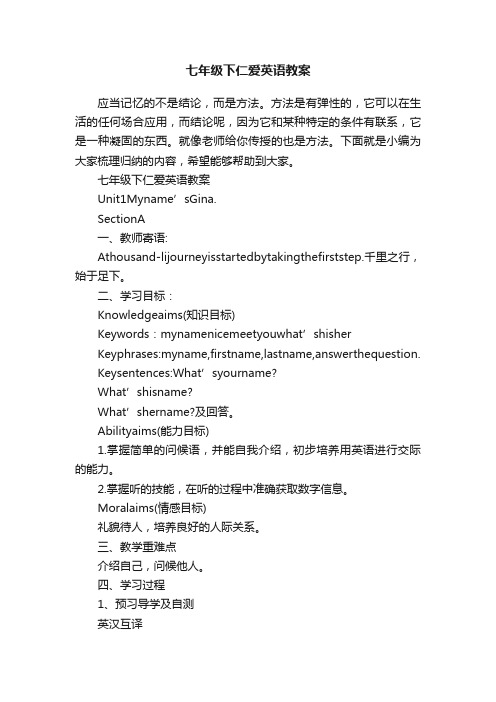
七年级下仁爱英语教案应当记忆的不是结论,而是方法。
方法是有弹性的,它可以在生活的任何场合应用,而结论呢,因为它和某种特定的条件有联系,它是一种凝固的东西。
就像老师给你传授的也是方法。
下面就是小编为大家梳理归纳的内容,希望能够帮助到大家。
七年级下仁爱英语教案Unit1Myname’sGina.SectionA一、教师寄语:Athousand-lijourneyisstartedbytakingthefirststep.千里之行,始于足下。
二、学习目标:Knowledgeaims(知识目标)Keywords:mynamenicemeetyouwhat’shisherKeyphrases:myname,firstname,lastname,answerthequestion.Keysentences:What’syourname?What’shisname?What’shername?及回答。
Abilityaims(能力目标)1.掌握简单的问候语,并能自我介绍,初步培养用英语进行交际的能力。
2.掌握听的技能,在听的过程中准确获取数字信息。
Moralaims(情感目标)礼貌待人,培养良好的人际关系。
三、教学重难点介绍自己,问候他人。
四、学习过程1、预习导学及自测英汉互译_________2.好的,令人愉快的______________3.too___________4.遇见______5.your____________6.his_________7.她的名字______2、自主学习①.onenum.1,一:Oneandtwomakesthree.一加二等于三。
adj.①一个:Ihaveonebook.我有一本书。
②有一(天):Onedayhewillunderstandyou.有一天他会理解你的。
②meet/mi:t/v.遇到,碰到【记忆法】-ee-双写,与meat为同音词。
【考点】tomeetsb.(orsth.)遇到某人/某事:Nicetomeetyou.初次见面时的客套话,不是初次见面时则用see。
初一仁爱版下册英语教案
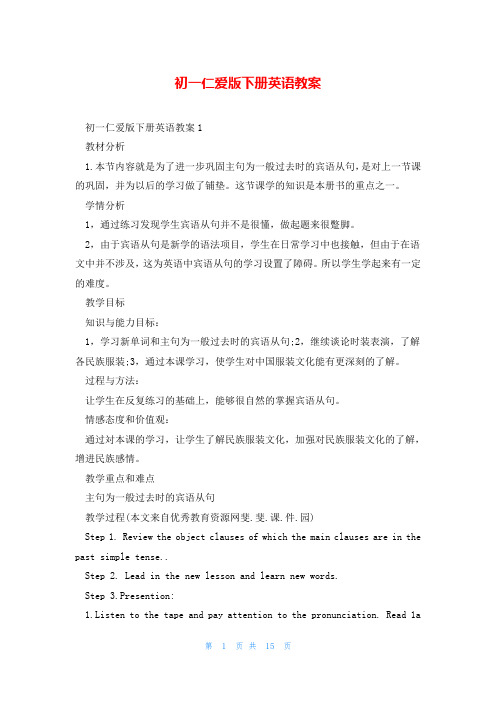
初一仁爱版下册英语教案初一仁爱版下册英语教案1教材分析1.本节内容就是为了进一步巩固主句为一般过去时的宾语从句,是对上一节课的巩固,并为以后的学习做了铺垫。
这节课学的知识是本册书的重点之一。
学情分析1,通过练习发现学生宾语从句并不是很懂,做起题来很蹩脚。
2,由于宾语从句是新学的语法项目,学生在日常学习中也接触,但由于在语文中并不涉及,这为英语中宾语从句的学习设置了障碍。
所以学生学起来有一定的难度。
教学目标知识与能力目标:1,学习新单词和主句为一般过去时的宾语从句;2,继续谈论时装表演,了解各民族服装;3,通过本课学习,使学生对中国服装文化能有更深刻的了解。
过程与方法:让学生在反复练习的基础上,能够很自然的掌握宾语从句。
情感态度和价值观:通过対本课的学习,让学生了解民族服装文化,加强对民族服装文化的了解,增进民族感情。
教学重点和难点主句为一般过去时的宾语从句教学过程(本文来自优秀教育资源网斐.斐.课.件.园)Step 1. Review the object clauses of which the main clauses are in the past simple tense..Step 2. Lead in the new lesson and learn new words.Step 3.Presention:1.Listen to the tape and pay attention to the pronunciation. Read 1ain different ways to learn it2. Let the students answer some questi. And then fill in blanks according to 1a.Step 4. PracticeLead into Part 2and practice the object clauses of which the main clauses are in the past simple tense.Step 5.Colidation :Step 6.Homework:教学环节一,复习二,导入三,呈现四,练习五,巩固六,作业复习宾语从句,然后利用宾语从句引入新课,并展示图片,学习生词,进而学习少数民族服装,处理第三部分。
仁爱版英语七年级下全册教案 (1)

仁爱版英语七年级(下)教案Unit 5一、【教学目标】(一)语言知识语音/t/ /d/ /ts/ /dz/ /tr/ /dr/ /l/ /m/ /n/词汇掌握wake,early, first,day, term,must,still,by,on foot,the same to,usually,always,Ms.,boat,ship,sea,train,by plane/air/airplane, etc.理解Subway Worm reporter,Net Bar,roller skating Measure dining hall,dormitory bookstore,etc.(二)语法1.一般现在时(Simple present)2.频度副词(Adverbs of frequency)never,seldom,sometimes,often,usually,always,once,twice3.现在进行时(Present continuous)I’m looking for a book.Are you doing your homework?Yes,I am./No,I m not.Is he/she...?Yes,he/she is./No,he/she isn’t.What are you doing now?I’m playing computer games.What is he/she doing?He/She is...4.谈论交通方式(Talking about means of transport)How do you usually go to school? I usually go to school by bike.(三)功能用语与话题1.采访(Interviews)Our guest today is Michael from Class 2,Grade 1.2.谈论日常生活(Talking about routines)3.学校建筑(School buildings)swimming pool,playground,library,dormitory,lab,canteen,gym4.谈论兴趣喜好(Talking about interests,likes and dislikes)I like the swimming pool best. Why do you like English? Because it’s interesting and easy.5.借物(Borrowing things)How long can I keep it? Two weeks.6.新闻(News)、海报(Poster)Attention,please! Here is the news.7.谈论学校活动、科目和时间表(Talking about school activities,subjects and timetable)8.谈论学校生活(Talking about school life)(四)能力培养【听】能听懂谈论校园生活中比较熟悉的话题,识别主题,获取主要信息。
七年级英语下册全册教案(仁爱版)

七年级英语下册全册教案(仁爱版)Step 3 Consolidation 第三步巩固(时间:12分钟)巩固1a, 完成1b。
1. (再次播放1a录音, 让学生跟读, 注意新单词的读音。
)T: Please listen again and follow the tape. Pay attention to the pronunciation of the new words.2. (把全班分成4个小组,教师提问。
采用竞争机制, 看哪个小组回答问题最多, 则该小组为优胜小组,从而让学生对节日的日期、食物及相关活动有更深记忆。
完成1b。
) T:I will divide you into four groups and ask you some questions about the festivals. Try to answer the questions. The group which answers the most questions will be the winner.T:When is the Spring Festival?G1:It’s in January or February/on lunar January 1st.T:What food do Chinese people eat on the Spring Festival?G2:Dumplings.T:How do people celebrate it?G3:Perform lion and dragon dances.T:…G4:……(小组里的学生每答对一个问题, 教师在下面表里为该组记上1分。
)Group1234Point3. (让学生根据小黑板上Step 2的表格内容, 复述每个节日。
)T:Now, please tell me how people celebrate those festivals according to the form on the blackboard.S1:The Spring Festival is in January or February. People eat dumplings and perform lion and dragon dances.S2:Christmas is on December 25th. People give each other presents.S3:Thanksgiving is on the fourth Thursday in November. Families get together for a big dinner. People eat turkey and pumpkin pie.S4:The Lantern Festival is on lunar January 15th. People eat sweet dumplings. People watch lantern shows and guess riddles on lanterns.4. (小组讨论。
最新仁爱版七年级英语下册全英文教案(全英文全册)

七耳怨英语下册全英夂教秦(全英夂全册)科厂英语Λ幅:七坪銀教师: ________________聲特科屮M嗾教学进度表姓名修或麻债亿录班级座位表最新仁爱版七年级英语下册全英文教案(全英文全册)1. Do 2a. StUdy the example to UnderStand the two WayS Of expressing means Of transportation. Then fill in the blanks in 2a. DiSCUSS and CheCk the answers ・2. Make the StUdentS find the rules Of two WayS Of expressing the Same meaning by themselves. HeIP them CheCk the rules.3. Do 2b. ASk and answer questions about the PiCtUreS in 2a , USing two WayS Of expressing means Of transportation. HeIP the StUdentS to express correctly.4. Do 3. Read the form in 3 before IiStening ・ PrediCt the IiStening material ・ Leam the new words: WatCh TV. SOCCer/football, movie/film. Then IiSten to the PaSSage about NanCy ,s activities and CheCk the COrreCt answers individually. Then CheCk the answersBlaCkbOard DeSignTOPiC 1 I USUany COme to SChOOl by subway. SeCtiOn B 1. IaIWaySgetIJPdtSiX (/clock ・ 2. The early bird CatCheS the WOrm ・3.I IISllaIIy COme to SChOOl On foot, but SOmetimeS by bike ・I SeldOm Walk to SChOOL I never COnIe to SChOOl by subway. 2. Li Xiang Often COmeS to SChOOl by bike ・Li Xiang Often rides a bike to school.never(()%) Sel(IOIn SOnletinIrS Often IISuaIIy always(100%)I 1—^1I —I ——~~Thinking after teaching:Step4 PraCtiCe (IOS)Homework:1 .Recite 10 WOrdS and finish WOrkbOOk ・ 2. P ι*actice the COnVerSatiOn Of la;3. Preview SeCtiOn C-la.StePl ReViSe (IOS)Step2 PreSentatiOn (IOS)Step3COnSOIidatiOn(IOS)Step4 PraCtiCe (IOS)1. H ave a diction.(IOwords)2. Help the StUdentS to revise the WOrdS about the days Of a Week and subjects.1. PreSent new WOrdS and new PattemS With the help Of the flashcardsand context.2. Do la. LOOk at the PiCtUre in la. PrediCt the IiStening material in la. Then IiSten to the tape and COmPlete the two COkImnS in the table in lb. Then IiSten again and COmPlete the third CoIUmn in lb. CheCk the answers.1. R ead Ia after the tape.2.r ∏ιen PraCtiCetlιeCOnVerSatiOn in Ia in PairS ・ 3. Do lb. L∞k at the table in lb. Try to Say the SentenCeS With the help Of the table.(让学生说完整的句子)1 .Create SitUatiOnS to PreSent the new phrase. CheCk the answers ・Make the StUdentS PraCtiCe the WOrdS Of SUbjeCtS orally.2. Ask and answer questions With your Partner With the PhraSeS in the box in 2a.3. Do 2b. Make the StUdentS PraCtiCe the expressions about IikeS and dislikes ・4. Work in PairS ・ LOOk at the PiCtUreS in 2b and make UP new conversations. PraCtiCe the COnVerSatiOnS in PairS ・5. D O 3.Make the StUdentS USe the expressions about IikeS and dislikes in Oral WOrk and Written WOrk after Iearning ・StePl ReViSe (IOS)Step2 PreSentatiOn (IOS)Step3 COnSOIidatiOn(IOS)Step4 PraCtiCe (IOS)l.Have a diction.(IOwords)2Revise the WOrdS about the days Of a Week and subjects. 3.Show SOme PhOtOS about sch∞l activities to arouse the StudentSqinterests.1. D o la. PreSent new WOrdS in the context. PrediCt the reading materialbefore reading ・2. L OOk at the PiCtUreS in la. Read the StatementS before reading the material. Try to guess TrUe Or FaISe before reading ・3. R ead the PaSSage in Ia individually. CirCle TnJe Or False. Then CheCk your answers With your Partner.Help the StUdentS CheCk their answers WhiIe reading ・1 .Try to SUmmariZe the main idea Of each ParagraPh.Help the StUdentS Iearn to USe their OWn WOrdS to SUnImariZe the main idea ・2.Do lb. Read Ia again and fill in the blanks in Ib individually. CheCk the answers ・1. Look at the news and POSterS in2. Try to guess the COntent in them. Then read the news and POSterS about HU Biιι,s interesting SChOOl Iife and fill iιι the blanks iιι the following table.2. Make the StUdentS Iearn to make POSterS and news by themselves ・3. Do 4a. Read the WOrdS in 4a individually. Then read the WOrdS to your partner.4. Do 4b. Read the WOrdS On PPT together, where, bear, there, chair, near, here ・ Read the Chant after the tape ・ Pay attention to the rhythm. Then PraCtiCe the Chant in PairS ・最新仁爱版七年级英语下册全英文教案(全英文全册)。
仁爱版英语七年级下全册教案

仁爱版英语七年级(下)教案Unit 5一、【教学目标】(一)语言知识语音/t/ /d/ /ts/ /dz/ /tr/ /dr/ /l/ /m/ /n/词汇掌握wake,early, first,day, term,must,still,by,on foot,the same to,usually,always,Ms.,boat,ship,sea,train,by plane/air/airplane, etc.理解Subway Worm reporter,Net Bar,roller skating Measure dining hall,dormitory bookstore,etc.(二)语法1.一般现在时(Simple present)2.频度副词(Adverbs of frequency)never,seldom,sometimes,often,usually,always,once,twice3.现在进行时(Present continuous)I’m looking for a book.Are you doing your homework?Yes,I am./No,I m not.Is he/she...?Yes,he/she is./No,he/she isn’t.What are you doing now?I’m playing computer games.What is he/she doing?He/She is...4.谈论交通方式(Talking about means of transport)How do you usually go to school? I usually go to school by bike.(三)功能用语与话题1.采访(Interviews)Our guest today is Michael from Class 2,Grade 1.2.谈论日常生活(Talking about routines)3.学校建筑(School buildings)swimming pool,playground,library,dormitory,lab,canteen,gym4.谈论兴趣喜好(Talking about interests,likes and dislikes)I like the swimming pool best. Why do you like English? Because it’s interesting and easy.5.借物(Borrowing things)How long can I keep it? Two weeks.6.新闻(News)、海报(Poster)Attention,please! Here is the news.7.谈论学校活动、科目和时间表(Talking about school activities,subjects and timetable)8.谈论学校生活(Talking about school life)(四)能力培养【听】能听懂谈论校园生活中比较熟悉的话题,识别主题,获取主要信息。
仁爱版英语七年级下全册教案 (1)

仁爱版英语七年级(下)教案Unit 5一、【教学目标】(一)语言知识语音/t/ /d/ /ts/ /dz/ /tr/ /dr/ /l/ /m/ /n/词汇掌握wake,early, first,day, term,must,still,by,on foot,the same to,usually,always,Ms.,boat,ship,sea,train,by plane/air/airplane, etc.理解Subway Worm reporter,Net Bar,roller skating Measure dining hall,dormitory bookstore,etc.(二)语法1.一般现在时(Simple present)2.频度副词(Adverbs of frequency)never,seldom,sometimes,often,usually,always,once,twice3.现在进行时(Present continuous)I’m looking for a book.Are you doing your homework?Yes,I am./No,I m not.Is he/she...?Yes,he/she is./No,he/she isn’t.What are you doing now?I’m playing computer games.What is he/she doing?He/She is...4.谈论交通方式(Talking about means of transport)How do you usually go to school? I usually go to school by bike.(三)功能用语与话题1.采访(Interviews)Our guest today is Michael from Class 2,Grade 1.2.谈论日常生活(Talking about routines)3.学校建筑(School buildings)swimming pool,playground,library,dormitory,lab,canteen,gym4.谈论兴趣喜好(Talking about interests,likes and dislikes)I like the swimming pool best. Why do you like English? Because it’s interesting and easy.5.借物(Borrowing things)How long can I keep it? Two weeks.6.新闻(News)、海报(Poster)Attention,please! Here is the news.7.谈论学校活动、科目和时间表(Talking about school activities,subjects and timetable)8.谈论学校生活(Talking about school life)(四)能力培养【听】能听懂谈论校园生活中比较熟悉的话题,识别主题,获取主要信息。
仁爱版英语七年级下册教案

仁爱版英语七年级下册教案《仁爱版英语七年级下册教案》为题在七年级下学期的英语课程中,我们将继续使用仁爱版英语教材。
为了帮助学生更好地学习英语,我们准备了一份教案,旨在引导学生进行全面、系统的学习。
第一课:Unit 1 My School Day1. Learning Objectives- Enable students to talk about their school day in English. - Familiarize students with the vocabulary related to school subjects and daily routines.- Develop students' listening, speaking, reading, and writing skills.2. Warm-up- Show pictures of different school subjects and ask students to name them in English.- Play a short video clip of a typical school day routine and ask students to describe what they see.3. Vocabulary- Introduce new vocabulary related to school subjects and daily routines through flashcards, word games, and real-life examples.4. Listening- Play an audio recording of a student's school day routine and ask students to listen and fill in the missing information on a worksheet.5. Speaking- Divide students into pairs and ask them to interview each other about their typical school day routine using the targetvocabulary.6. Reading- Provide students with a short reading passage about a school day routine and ask them to answer comprehension questions.7. Writing- Ask students to write a short paragraph about their own school day routine, using the vocabulary and sentence structures learned in class.8. Extension Activities- Role play: Divide students into groups and ask them to act out a school day routine, using the target vocabulary and sentence structures.- Vocabulary word search: Provide students with a word search worksheet containing the vocabulary words learned in this unit.第二课:Unit 2 My Hobbies1. Learning Objectives- Enable students to talk about their hobbies in English.- Familiarize students with the vocabulary related to different hobbies.- Develop students' listening, speaking, reading, and writing skills.2. Warm-up- Show pictures of different hobbies and ask students to name them in English.- Play a short video clip of people engaging in different hobbies and ask students to describe what they see.3. Vocabulary- Introduce new vocabulary related to hobbies through flashcards, word games, and real-life examples.4. Listening- Play an audio recording of people talking about their hobbies and ask students to listen and match the hobbies with the correct person on a worksheet.5. Speaking- Divide students into groups and ask them to discuss their favorite hobbies using the target vocabulary. Each group should appoint a spokesperson to present their findings to the class.6. Reading- Provide students with a short reading passage about different hobbies and ask them to answer comprehension questions.7. Writing- Ask students to write a short paragraph about theirfavorite hobby, using the vocabulary and sentence structures learned in class.8. Extension Activities- Hobby showcase: Ask students to bring in an item or a picture related to their favorite hobby and present it to the class, explaining why they enjoy it.- Hobby survey: Divide students into pairs and ask them to conduct a survey among their classmates to find out the most popular hobbies in the class.第三课:Unit 3 My Family1. Learning Objectives- Enable students to talk about their family members in English.- Familiarize students with the vocabulary related to family members and relationships.- Develop students' listening, speaking, reading, and writingskills.2. Warm-up- Show pictures of different family members and ask students to name them in English.- Play a short video clip about a family gathering and ask students to describe what they see.3. Vocabulary- Introduce new vocabulary related to family members and relationships through flashcards, word games, and real-life examples.4. Listening- Play an audio recording of a person talking about their family and ask students to listen and answer comprehension questions.5. Speaking- Divide students into pairs and ask them to interview each other about their family members and relationships using the target vocabulary.6. Reading- Provide students with a short reading passage about a family and ask them to answer comprehension questions.7. Writing- Ask students to write a short paragraph about their own family, using the vocabulary and sentence structures learned in class.8. Extension Activities- Family tree: Ask students to create a family tree, labeling each family member with the appropriate vocabulary words.- Family interview: Divide students into pairs and ask them to interview their family members about their family history, traditions, and customs.本教案只写了前三课的内容,希望能够帮助学生更好地学习英语。
仁爱版英语七年级下册全册教案(详细)
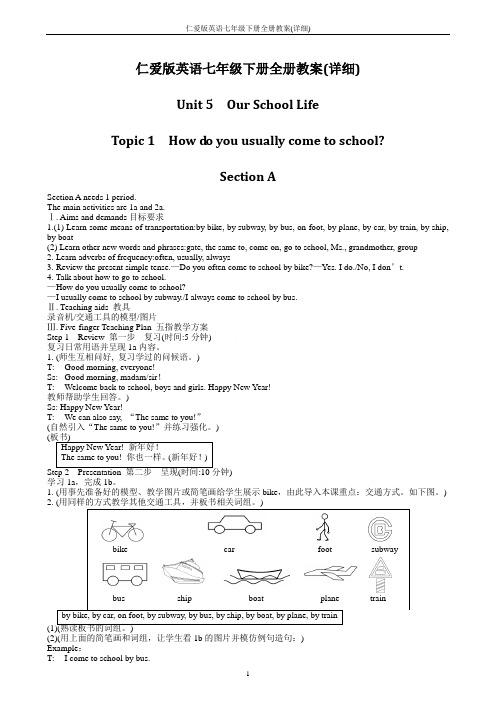
bike
car
foot
subway
bus
ship
boat
plane
train
by bike, by car, on foot, by subway, by bus, by ship, by boat, by plane, by train
(1)(熟读板书的词组。) (2)(用上面的简笔画和词组,让学生看 1b 的图片并模仿例句造句:) Example: T: I come to school by bus.
2
仁爱版英语七年级下册全册教案(详细)
3. (让学生听录音, 完成 2b。掌握生词 Ms.和 grandmother。) T: Next, we will have a listening practice. Let’s find out how people come to school or come to work. Do you
understand?
Ss: Yes, we do. (播放录音,并核对答案。) Step 5 Project 第五步 综合探究活动(时间:15 分钟) 用表达交通工具的名词和频度副词进行实践调查, 完成 3。 1. (使用多媒体课件、flash 动画或简笔画, 让学生展开想象, 任意造句子, 要求用上交通工具的表达用语和 频度副词。) T: Let’s look at the pictures. I’m sure you are interested in these lovely pictures. Please make sentences as you like, and don’t forget to use these means of transportation and adverbs of frequency. Are you ready? Go! 2. (让学生分组做一个关于 how to come to school 的调查报告并完成 3。调查时,强调用“How do you usually come to school?”和“I usually come to school…”句型,掌握生词 group。)
仁爱版英语七年级下册教学设计

杨立春
Contents:
Unit 7 Topic2 Section A
Teaching aims
1、Learn the new phrase;
2、Learn the usage of “can” and “can’t” for ability and inability;
2、Practice1ain pairs. Then act it out.
Step4:Practice
1、Let the students finish 2 by s. And then check the answers;
2、Pair work.
Let the students ask and answer in pairs according to the example and phrases in 3.And master alternative questions.
2、Ask and answer between the teacher and the students.
3、Let the students listen to1aand follow it.
Step3:Consolidation
1、Let the students listen to1aagain, and then finish 1b;
1、What else can you do?;
2、Can you dance or draw?
Teaching plan
Students’ activities
Teaching steps:
Step2:Presentation
1、Lead to the sentence pattern “can you…?”
仁爱版七年级下册英语教案
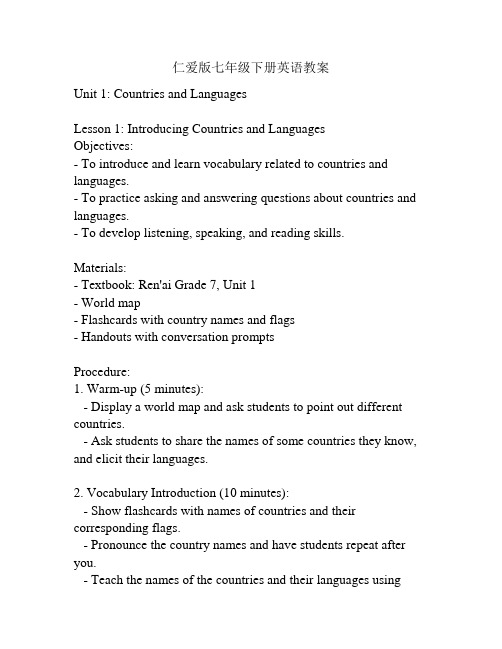
仁爱版七年级下册英语教案Unit 1: Countries and LanguagesLesson 1: Introducing Countries and LanguagesObjectives:- To introduce and learn vocabulary related to countries and languages.- To practice asking and answering questions about countries and languages.- To develop listening, speaking, and reading skills. Materials:- Textbook: Ren'ai Grade 7, Unit 1- World map- Flashcards with country names and flags- Handouts with conversation promptsProcedure:1. Warm-up (5 minutes):- Display a world map and ask students to point out different countries.- Ask students to share the names of some countries they know, and elicit their languages.2. Vocabulary Introduction (10 minutes):- Show flashcards with names of countries and their corresponding flags.- Pronounce the country names and have students repeat after you.- Teach the names of the countries and their languages usinggesture and context.- Drill pronunciation of the words.- Make sure students understand the meaning of each word.3. Listening Exercise (15 minutes):- Play an audio recording of a conversation about countries and languages.- Students listen and complete the missing information about the countries and languages.- Play the audio again if necessary.- Check the answers as a class.4. Speaking Practice (15 minutes):- Divide students into pairs.- Provide each pair with a handout containing conversation prompts.- Students take turns asking and answering questions about countries and languages.- Monitor and provide assistance if needed.- Encourage students to use complete sentences and proper pronunciation.5. Reading Comprehension (10 minutes):- Assign the reading passage in the textbook related to countries and languages.- Instruct students to read silently and answer the comprehension questions.- Check the answers as a class.6. Homework (5 minutes):- Assign a written task for homework, such as writing a short paragraph about their favorite country and its language.- Remind students to include relevant vocabulary and proper sentence structure.Assessment:- Observe students' participation and engagement during the speaking practice.- Evaluate students' comprehension through their answers in the listening exercise and reading comprehension.。
仁爱版七年级下册英语教学计划(通用28篇)

仁爱版七年级下册英语教学计划(通用28篇)仁爱版七年级下册英语教学计划仁爱版七年级下册英语教学计划(通用28篇)光阴如水,我们的教学工作又迈入新的阶段,是时候写一份详细的教学计划了。
那么教学计划怎么写才能体现你的真正价值呢?下面是小编整理的仁爱版七年级下册英语教学计划(通用28篇),希望能够帮助到大家。
仁爱版七年级下册英语教学计划1一、学生情况简析七年级共两个班,大部分学生学习目的明确,学习态度端正,掌握了英语学习的一些基本方法,能够积极主动认真地学习,学习成绩较好。
但还有少部分学生没有明确学习目的,缺少学习的热情和主动性,自觉性和自控力都较差,相应的学习习惯也差。
,学生觉得英语学习是一种负担,而不是一种乐趣。
一部分学生没有掌握记忆单词的方法,连基本的单词听写也不过关,导致看不懂,听不懂,学不懂。
二、教材总体分析七年级下册英语共十二个单元,另外还有两个复习单元,每个单元都列出明确的语言目标,主要的功能项目与语法结构,需要学生掌握的基本词汇,并分为A、B两部分。
A部分以一副展示新功能在实际生活中运用的图画开篇。
该图引出了学生在操练新语言时需要用到的重点词汇。
所有重点单词都在图画中描绘出来,因此学生不需解释或翻译就能理解它们。
新的表达方式呈现在人物头上的气泡中,从而使学生很容易理解和操练新语言。
B部分在循环A部分所呈现的语言同时引出新的词汇。
同时,B部分的活动帮助学生整合新的目标语言和前面单元学过的语言。
这一循环强化了前面的语言学习,同时为新学语言提供了更多的操练机会。
三、教学目标1、词汇方面:掌握本册教材中的词汇,学会根据单词的读音规则去记忆单词,掌握单词,词组的用法。
2、语言结构方面:学会谈论人们的国籍,居住城市,学会询问及表达某一场所的位置,学会描述动物,表达喜好并陈述原因,学会谈论自己与他人的职业,学会谈论人们正在做的事情,描述并谈论天气,表达自己对天气的喜好及原因,描述某人的外貌特征,订餐或点菜,表达过去发生的事情,交流对某人,某事,某物的看法等。
仁爱版七年级英语下册教案

仁爱版七年级英语下册教案Topic 1 What’s the weather like in winter? Section A一、教学目标分析1、知识目标A、学习和掌握有关季节和天气的词汇:weather, spring, warm, season, summer, hot, winter, cold, rain, snow, ;B、熟练掌握和运用功能用语,谈论喜欢的季节特征以及喜欢的原因:(1)What’s the weather like in …?/ How is the weather in …? It’s …(2)It’s a good season/ time to do sth.(3)It’s a good season/ time for doing sth.(4)Which season do you like best? I like … best.(5)Why do you like it? Because ….2、能力目标1. 听:能听懂谈论四季特征和喜欢原因的对话;2. 说:(1)能使用英语准确描述四季特征及适合开展的活动;(2)能使用英语正确表达自己喜欢的季节及喜欢的原因;3. 读:能正确朗读对话,并读懂对话,掌握主要信息;4. 写:能写出描述四季特征的句子和短文。
3、情感态度a) 热爱大自然,乐于参加户外活动,培养积极、健康、向上的性格;b) 有愿望和兴趣参与各种英语实践活动,敢于用英语表达自己的感受;c) 在小组活动中积极与他人合作,互相帮助,发扬团队精神,共同完成学习任务。
4、学习策略a) 能对所学语言材料中的语言规律进行总结和归纳,并加以利用;b) 能够主动地在听说交际中运用所学的语言知识;c) 善于抓住英语交际的实践机会。
5、文化意识让学生了解并掌握:谈论天气是英国人见面时最常提及的话题这一文化背景。
二、教学重点、难点分析教学重点:谈论四季、四季的天气特征以及适合开展的活动,并学会表达对四季的喜欢及原因。
七年级英语下册全册教案(仁爱版)
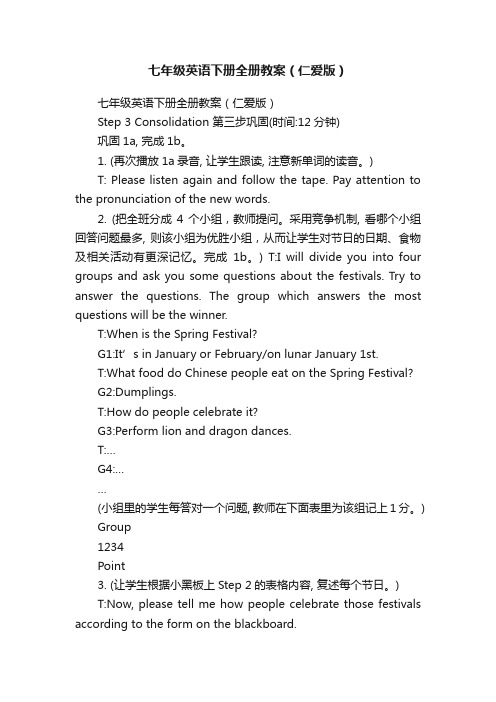
七年级英语下册全册教案(仁爱版)七年级英语下册全册教案(仁爱版)Step 3 Consolidation 第三步巩固(时间:12分钟)巩固1a, 完成1b。
1. (再次播放1a录音, 让学生跟读, 注意新单词的读音。
)T: Please listen again and follow the tape. Pay attention to the pronunciation of the new words.2. (把全班分成4个小组,教师提问。
采用竞争机制, 看哪个小组回答问题最多, 则该小组为优胜小组,从而让学生对节日的日期、食物及相关活动有更深记忆。
完成1b。
) T:I will divide you into four groups and ask you some questions about the festivals. Try to answer the questions. The group which answers the most questions will be the winner.T:When is the Spring Festival?G1:It’s in January or February/on lunar January 1st.T:What food do Chinese people eat on the Spring Festival?G2:Dumplings.T:How do people celebrate it?G3:Perform lion and dragon dances.T:…G4:……(小组里的学生每答对一个问题, 教师在下面表里为该组记上1分。
) Group1234Point3. (让学生根据小黑板上Step 2的表格内容, 复述每个节日。
)T:Now, please tell me how people celebrate those festivals according to the form on the blackboard.S1:The Spring Festival is in January or February. People eat dumplings and perform lion and dragon dances.S2:Christmas is on December 25th. People give each other presents.S3:Thanksgiving is on the fourth Thursday in November. Families get together for a big dinner. People eat turkey and pumpkin pie.S4:The Lantern Festival is on lunar January 15th. People eat sweet dumplings. People watch lantern shows and guess riddles on lanterns.4. (小组讨论。
仁爱版七年级英语下册说课稿:Unit7Topic2SectionC

在总结反馈阶段,我会引导学生进行自我评价,并提供有效的反馈和建议。首先,我会让学生回顾和总结本节课所学的知识点,鼓励他们分享自己的理解和体会。然后,我会根据学生的回答和表现,给予积极的反馈和鼓励,同时指出他们需要改进的地方,并提供具体的建议和指导。通过这种方式,学生能够更好地自我评价和反思,提高他们的学习效果。
3.情感态度与价值观目标:通过本节课的学习,学生能够增强对英语学习的兴趣和自信心,培养积极的学习态度。同时,学生能够理解和尊重不同的文化背景,提高自己的跨文化交际能力。
(三)教学重难点
1.教学重点:本节课的教学重点是一般现在时态的构成和用法,疑问句和否定句的构成和用法,以及被动语态的构成和用法。这些知识点是英语学习的基础,对于学生的语言运用和思维发展具有重要意义。
仁爱版七年级英语下册说课稿:Unit7Topic2SectionC
一、教材分析
(一)内容概述
本节课的教学内容为仁爱版七年级英语下册Unit 7 Topic 2 Section C。整个课程体系中,本节课位于第三册教材的中段部分。主要知识点包括:一般现在时态的构成和用法,一般现在时的疑问句和否定句的构成和用法,以及一般现在时态的被动语态的构成和用法。此外,本节课还涉及一些与日常生活相关的词汇和短语,如“go to school”,“do homework”,“play basketball”等。
(三)巩固练习
为了帮助学生巩固所学知识并提升应用能力,我计划设计多样化的巩固练习和实践活动。首先,我会设计一些填空题和选择题,让学生通过选择正确的动词形式和构造疑问句或否定句来巩固所学的语法知识。然后,我会组织学生进行小组讨论和角色扮演,让他们在实际语境中运用所学知识进行交流和表达。此外,我还会让学生完成一些实际任务,如编写小故事、制作海报等,让他们在实际操作中运用所学知识,提高他们的综合应用能力。
仁爱版英语七年级下册Unit 5 Topic 3《My school life is very in

仁爱版英语七年级下册Unit 5 Topic 3《My school life is very interesting》(SectionA)教案一. 教材分析本单元的主题是“My school life is very interesting”,主要让学生们通过阅读和交流,了解不同学生的学校生活,并学会用英语表达自己的学校生活。
本节课主要学习Section A的内容,包括两个对话和一个任务。
两个对话分别是Mike和Sarah谈论他们的学校生活,以及Liu Tao和他的朋友们在课间休息时的活动。
任务是回答关于学校生活的问题,并进行简单的介绍。
二. 学情分析七年级的学生已经掌握了一些基本的英语语法和词汇,能够进行简单的听、说、读、写操作。
但是,对于一些复杂的语法和词汇,他们可能还不够熟悉,需要教师的耐心指导和反复练习。
此外,学生的学习兴趣和动机也是影响教学效果的重要因素,因此,教师需要通过生动有趣的教学活动,激发学生的学习兴趣和动机。
三. 教学目标1.能够听懂、说出一系列的学校生活相关的词汇,例如:classroom,teacher, school, friend, study, play, music, sport等。
2.能够通过阅读和交流,了解不同学生的学校生活,并学会用英语表达自己的学校生活。
3.能够运用所学的词汇和语法,回答关于学校生活的问题,并进行简单的介绍。
四. 教学重难点1.学校生活相关的词汇和短语的学习和应用。
2.一般现在时的语法结构和用法。
3.听力和口语的练习,特别是对于一些细节的把握和表达。
五. 教学方法1.交际式教学法:通过创设真实、有意义的情景,让学生在交流中学习英语,提高他们的语言运用能力。
2.任务型教学法:通过完成各种任务,让学生在实践中学习英语,提高他们的学习兴趣和学习动机。
3.视听教学法:通过观看录像、听录音等手段,提高学生的听力和口语能力。
六. 教学准备1.教材和教学参考书。
仁爱版英语七年级下册教学设计

The students should discuss in groups of four and discover knowledge by themselves.
The students should listen carefully and dowhatthe teachertellsthemto ..
Teaching plan
Students’activities
Teaching steps:
Step2:Presentation
1、Lead to the sentence pattern “can you…?”
2、Ask and answer between the teacher and the students.
Step5:Homework
1.Read1athree timesafter class;
2.Finish the workbook;
3.Describe yourselves with can or can’t
Afterthe teacher gavean example,the students practise ingroups.
3、Let the students listen to1aand follow it.
Step3:Consolidation
1、Let the students listen to1aagain, and then finish 1b;
2、Practice1ain pairs.Then act it out.
Teaching focus
仁爱版七年级下册英语教案

仁爱版七年级下册英语教案一、教学目标。
1. 语言知识目标。
- 学生能够掌握课本中的重点单词、短语和句型。
例如,重点单词如“subject”(学科)、“favorite”(最喜欢的)等;短语如“have a rest”(休息)、“go to school”(去上学)等;句型如“What day is it today?”(今天星期几?)“My favorite subject is English.”(我最喜欢的学科是英语。
)- 能够正确使用一般现在时描述日常活动、喜好等。
2. 语言技能目标。
- 听:学生能听懂关于日常活动、学校课程安排等话题的简单对话。
- 说:能够运用所学单词和句型就学校生活、兴趣爱好等话题进行简单的交流对话。
- 读:能读懂简单的关于学校生活、人物喜好的短文。
- 写:能够写出简短的介绍自己学校生活、喜好学科等的小短文。
3. 情感态度目标。
- 培养学生对英语学习的兴趣,积极参与课堂互动。
- 引导学生热爱学校生活,珍惜学习时光。
二、教学重难点。
1. 教学重点。
- 重点单词、短语和句型的记忆与运用。
- 一般现在时的用法,包括第三人称单数形式的动词变化。
2. 教学难点。
- 一般现在时中第三人称单数形式动词变化规则的理解与正确运用。
- 如何引导学生在实际情境中灵活运用所学句型进行交流。
三、教学方法。
1. 情景教学法。
- 通过创设学校生活、家庭生活等情景,帮助学生理解和运用所学知识。
例如,创设课堂情景,让学生模拟上课,运用所学句型问问题、回答问题。
2. 任务驱动法。
- 布置各种任务,如小组讨论、角色扮演、调查等任务,让学生在完成任务的过程中学习和巩固知识。
例如,布置任务让学生调查小组成员最喜欢的学科并进行汇报。
3. 交际教学法。
- 鼓励学生之间、师生之间用英语进行交流互动,提高学生的英语口语表达能力。
四、教学过程。
1. 导入(5分钟)- 播放一首关于学校生活的英文歌曲,如“School Days”,然后提问学生从歌曲中听到了哪些与学校有关的单词,引出本节课的话题——学校生活。
仁爱版七年级英语下册全册教案

(2)Do you often come to school by bike?
(3)I usually come to school by subway/by bus/on foot.
2.Skill aims
能听懂有关表达交通方式的简单对话或叙述;
能根据图文就交通方式进行交流;
在情景对话中,能够表达“日常的交通方式、某项活动的频度”等语言功能,如:
1.I usually come to school on foot, but sometimes by bike.
2.I seldom walk to school. I often come by subway.
3.I never come to school by subway.
教 学
重 点
难 点
在对话操练、两两问答、小组调查等活动中,学习用频度副词来进行日常活动频率等的有关表达,同时还学习和操练用两种不同的表达(介词by加交通工具和动词短语)对交通方式进行问答及切换。
教 学
准 备
录音机、教学挂图、多媒体和黑板
教
学
过
程
1.Get students ready for learning.
park, watch, TV, television, watch TV, soccer, football, movie, film
在Section A的基础上,复习交通方式,能正确运用always, usually, sometimes, seldom, often, never等频度副词,同时能用介词by加交通工具和动词短语两种不同的方法来表示交通方式;
Preview Section B.
- 1、下载文档前请自行甄别文档内容的完整性,平台不提供额外的编辑、内容补充、找答案等附加服务。
- 2、"仅部分预览"的文档,不可在线预览部分如存在完整性等问题,可反馈申请退款(可完整预览的文档不适用该条件!)。
- 3、如文档侵犯您的权益,请联系客服反馈,我们会尽快为您处理(人工客服工作时间:9:00-18:30)。
浠佺埍,鐗?鑻辫,涓冨勾绾?涓嬪唽,鏁欐,浠佺埍,鐗?鑻辫,浠佺埍鐗堣嫳璇竷骞寸骇(涓?鏁欐
Unit 5
涓€銆併€愭暀瀛︾洰鏍囥€?
锛堜竴锛夎瑷€鐭ヨ瘑聽聽
璇煶聽 /锝? /锝? /ts/ /dz/ /tr/ /dr/ /锝? /锝? /n/
璇嶆眹聽鎺屾彙wake锛宔arly, first锛宒ay, term锛宮ust,still,by锛宱n foot,the same to,usually,always锛孧s.,boat锛宻hip锛宻ea锛宼rain锛宐y plane/air/airplane, etc.
鐞嗚В聽 Subway Worm reporter锛孨et Bar,roller skating Measure dining hall锛宒ormitory bookstore锛宔tc.
锛堜簩锛夎娉?
1.涓€鑸幇鍦ㄦ椂锛圫imple present锛?
2.棰戝害鍓瘝锛圓dverbs of frequency锛塶ever锛?seldom锛?sometimes锛?often 锛?usually锛?always锛?once锛?twice
3.鐜板湪杩涜鏃讹紙Present continuous锛?
I鈥檓 looking for a book.
Are you doing your homework?Yes锛?I am./No锛?I m not.
Is he/she...?Yes锛?he/she is./No锛?he/she isn鈥檛.
What are you doing now?I鈥檓 playing computer games.
What is he/she doing?He/She is...
4.璋堣浜ら€氭柟寮忥紙Talking about means of transport锛?
How do you usually go to school? I usually go to school by bike.
锛堜笁锛夊姛鑳界敤璇笌璇濋
1.閲囪锛圛nterviews锛塐ur guest today is Michael from Class 2锛?Grade 1.
2.璋堣鏃ュ父鐢熸椿锛圱alking about routines锛?
3.瀛︽牎寤虹瓚锛圫chool buildings锛塻wimming pool锛?playground锛?library 锛?dormitory锛?lab锛?canteen锛?gym
4.璋堣鍏磋叮鍠滃ソ锛圱alking about interests锛?likes and dislikes锛塈 like the swimming pool best. Why do you like English? Because it鈥檚 interesting and easy.
5.鍊熺墿锛圔orrowing things锛塇ow long can I keep it? Two weeks.
6.鏂伴椈锛圢ews锛夈€佹捣鎶ワ紙Poster锛堿ttention锛?please! Here is the news.
7.璋堣瀛︽牎娲诲姩銆佺鐩拰鏃堕棿琛紙Talking about school activities 锛?subjects and timetable锛?
8.璋堣瀛︽牎鐢熸椿锛圱alking about school life锛?
锛堝洓锛夎兘鍔涘煿鍏?
銆愬惉銆懧? 鑳藉惉鎳傝皥璁烘牎鍥敓娲讳腑姣旇緝鐔熸倝鐨勮瘽棰橈紝璇嗗埆涓婚锛岃幏鍙栦富瑕佷俊鎭€?
銆愯銆懧?1 鑳芥牴鎹彁绀鸿瘝璇村嚭鎰忔€濊繛璐殑鏍″洯鐢熸椿鐨勫彞瀛愩€?
2 鑳界敤绠€鍗曞璇濇弿杩版牎鍥敓娲汇€?
3 鑳芥牴鎹浘鐗囨垨鍊熷姪浠栦汉甯姪鎻忚堪鑷繁鎴栦粬浜虹殑鏍″洯鐢熸椿銆?
4 鑳戒笌浠栦汉鍚堜綔杩涜瑙掕壊鎵紨锛岃〃鐜版牎鍥敓娲汇€?
銆愯銆懧?1 鑳界悊瑙g畝鍗曠殑涔﹂潰琛ㄨ揪銆?
2 鑳藉噯纭湴鏈楄璇炬枃銆?
3 鑳借鎳傝〃鐜版牎鍥敓娲绘柟闈㈢殑鏂囩珷锛屽寘鎷牎鍥柊闂汇€佹捣鎶ャ€侀仐澶卞0鏄庛€佸け鐗╂嫑棰嗙瓑銆?
鍐櫬? 鑳藉啓鍑鸿〃鐜版牎鍥敓娲绘柟闈㈢殑绠€鍗曞彞瀛愩€傝兘鍐欏嚭绠€鍗曠殑鏍″洯鏂伴椈銆佹捣鎶ャ€侀仐澶卞0鏄庛€佸け鐗╂嫑棰嗙瓑銆?
鎯呮劅鎬佸害聽鍩瑰吇瀛︾敓绉瀬鍚戜笂鐨勬儏鎰熴€佹椿娉煎紑鏈楃殑涓€с€佹祿鍘氱殑瀛︿範鍏磋叮鍜屽ぇ鑳嗗疄璺电殑绮剧锛屾彁楂樺涔犳晥鐜囷紝鍩瑰吇瀛︾敓鐑埍瀛︽牎鐢熸椿锛屼箰浜庡鏍$敓娲荤殑鎰忚瘑銆?
瀛︿範绛栫暐聽绉瀬鎺㈢储閫傚悎鑷繁鐨勮嫳璇涔犳柟娉曪紝鍒╃敤鐜板疄鐢熸椿涓殑瀛︿範璧勬簮锛屽煿鍏讳换鍔″瀷瀛︿範鏂规硶涓庢妧宸с€?
浜屻€併€愭暀鏉愬垎鏋愩€?
鏈崟鍏冪殑浜ら檯鐢ㄨ涓昏鏄洿缁曞鐢熺殑瀛︽牎鐢熸椿灞曞紑鐨勶紝璋堣瀛︾敓鐨勪笂瀛︽柟寮忋€佷綔鎭椂闂淬€佽绋嬪畨鎺掋€佷笟浣欑敓娲荤瓑鍐呭锛岃繖浜涘唴瀹逛负瀛︾敓鎵€鐔熸倝锛屼究浜庡睍寮€璁ㄨ銆?
鏈崟鍏冪殑璇硶鍐呭涓昏鏄涔犱竴鑸幇鍦ㄦ椂銆佺幇鍦ㄨ繘琛屾椂浠ュ強琛ㄧず棰戝害鐨勫壇璇嶃€?
Topic 1
Section A
銆愭暀瀛︾洰鏍囥€戯細
1.璋堣浜ら€氬伐鍏峰強濡備綍涓婂銆?
2.瀛︿範鍙ュ瀷锛欻ow do you usually come to school?
I usually come to school by subway.
銆愰噸鐐广€?a鍜?a銆偮?聽聽銆愰毦鐐广€戣皥璁轰氦閫氬伐鍏峰強濡備綍涓婂銆? 銆愭暀鍏枫€懧?褰曢煶鏈?
銆愯鏃跺缓璁€戯細1锝?
銆愭暀瀛﹁繃绋嬨€戯細
绗竴姝ワ細澶嶄範
1.鏁欏鐢熷浣曞湪寮€瀛︾殑绗竴澶╃浉浜掗棶鍊欍€?
T: Good morning锛?class!聽聽聽 S: Good morning锛?Miss.../Mr...
T: Nice to see you again!聽聽聽聽 S: Nice to see you锛?too.
瀛︿範闂€欒锛?
T: Happy New Year!聽聽聽聽聽 S: The same to you.
鐒跺悗鑰佸笀璇达細Boys and is the first day of our new term.
瑙i噴today锛?new term銆?
鑰佸笀璇达細I often come to school by bus. My son often takes the subway to school. What about you?
瀛︿範璇嶇粍by bus锛?take the subway銆?
Notes: subway锛圓mE锛?underground锛圔rE锛?
2. 鍚綍闊?a锛屽洖绛旈棶棰橈細
锛?锛塇ow does Kangkang usually come to school?
锛?锛塇ow does Sally always come to school?
涓や汉涓€缁勪綔瀵硅瘽锛岀劧鍚庤3锝?瀵瑰悓瀛﹀埌鍓嶉潰琛ㄦ紨瀵硅瘽銆傦紙瀵瑰弬鍔犺〃婕旂殑鍚屽缁欎簣榧撳姳銆傦級瀹屾垚3b銆?
绗簩姝ワ細鍛堢幇
1.鑰佸笀鍚戜竴浜涘悓瀛︿緷娆″睍绀哄苟瀛︿範璇嶇粍锛歸ake up锛?get up锛?go to school锛?by bike绛夛紝鐒跺悗鍋氬姩浣滅粌涔犮€傝涓€鍚嶅悓瀛﹀湪鍓嶄綔鍔ㄤ綔锛屽叾浣欏悓瀛︾寽娴嬭瘝缁勩€?
2.鍚綍闊?锛屽洖绛旈棶棰橈細
What鈥檚 the time? / Is it time to get up?
Who wakes Kangkang up?聽聽聽聽聽聽聽聽聽聽瀹屾垚1銆?
3.鍒╃敤鍥剧敾锛屽畬鎴?銆?
4.鍚綍闊?锛屽畬鎴?銆?
绗笁姝ワ細宸╁浐
1.鏀惧綍闊?鍜?a锛屽鐢熻窡璇汇€?
2.瀛︾敓涓や汉涓€缁勮〃婕?鍜?a銆?
绗洓姝ワ細缁冧範
1.鍒嗙粍娲诲姩锛岃皥璁鸿嚜宸辨棭鏅ㄧ殑娲诲姩鎯呭喌銆?
2.鍙屼汉娲诲姩锛屽垎鍒敤涓嶅悓鐨勪氦閫氬伐鍏峰浘鐗囪繘琛岄棶绛旓細
A:How do you usually come to school?
B:I usually come to school...
渚嬪锛歰n foot锛?by bike锛?by bus锛?by car锛?by train锛?by subway锛?by boat/ship锛?by plane/air,瀹屾垚4銆?
3.璁╁鐢熷仛涓€涓皟鏌ユ姤鍛婏紝璋冩煡鍏ㄧ彮鍚屽鈥淗ow do you usually go to school?鈥濇寜浜烘暟浠庡鍒板皯鍒楁垚琛ㄦ牸锛屽悜澶у姹囨姤锛欼n our class 锛?fifteen students go to school by bike...瀹屾垚5銆?
绗簲姝ワ細缁煎悎鎺㈢┒娲诲姩聽
1.瀛︾敓浠ヨ〃鏍肩殑褰㈠紡灞曠ず鑷繁鐨勫浜洪€氬父鎵€閲囩敤鐨勪氦閫氭柟寮忋€?
2.璇峰悓瀛︽嵁鑷繁鎵€浜嗚В鐨勬儏鍐碉紝浠嬬粛鍏跺畠涓鐢熸棭鏅ㄧ殑娲诲姩鎯呭喌锛屽:
鈥淚n our class锛?some students usually wake up at 6鈭?0. They get up at 6鈭?5...鈥?
Section B
銆愭暀瀛︾洰鏍囥€戯細
1.澶嶄範Section A銆?
2.瀛︿範棰戝害鍓瘝銆?
銆愰噸鐐广€?锛?鍜?a聽聽聽銆愰毦鐐广€戯細棰戝害鍓瘝
銆愭暀鍏枫€懧? 褰曢煶鏈?
銆愯鏃跺缓璁€戯細1
銆愭暀瀛﹁繃绋嬨€戯細
绗竴姝ワ細澶嶄範
1.澶嶄範Section A 4锛岃繘琛宎 chain work 娲诲姩锛屾寜鐓ц嚜宸辩殑鎯虫硶鍥炵瓟闂
锛欻ow do you usually come to school?灏藉彲鑳戒笉閲嶅鍓嶉潰鍚屽鐨勭瓟璇。
